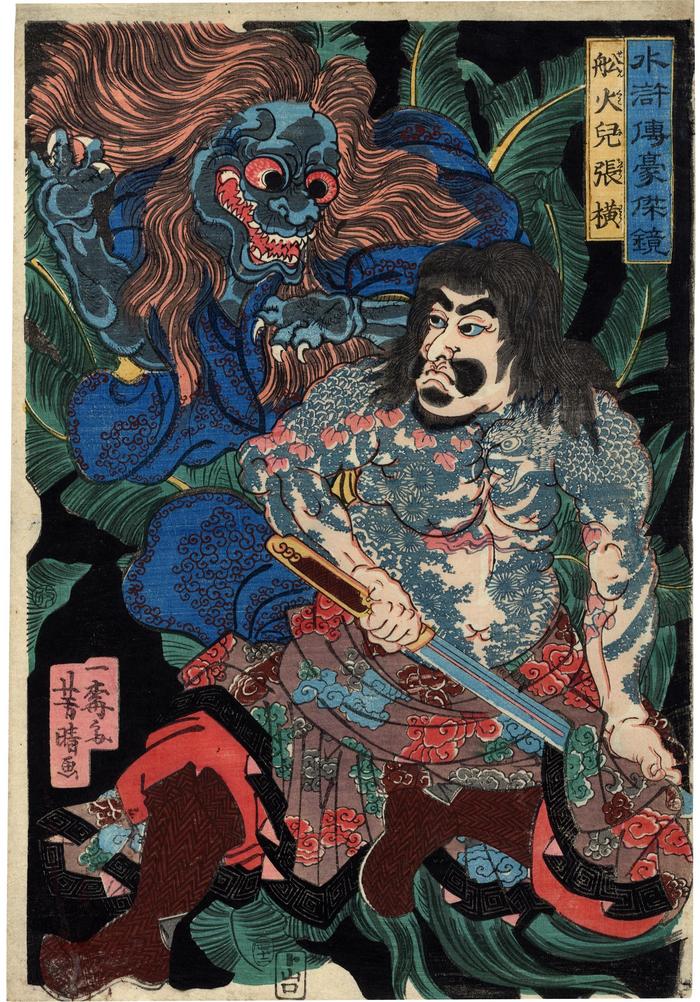Utagawa Yoshiharu (歌川芳春 or 芳晴) (artist 1828 – 1888)
Zhang Heng, the boatman, (Senkaji Chōō - 船火児張横) from the series Mirror of Heroes of the Shuihuzhuan (Suikoden gōketsu kagami - 水滸傳豪傑鏡)
12/1856
10 in x 14.75 in (Overall dimensions) Japanese color woodblock print
Signed: Ichibaisai Yoshiharu ga
一梅斎芳晴画
Publisher: Yamaguchiya Tōbei
(Marks 591 - seal not listed)
Combined date and censor seal:
aratame & Dragon 12
12/1856
British Museum - link to a Kuniyoshi print of Senkaji Chōō
Lyon Collection print of the same character by Kuniyoshi
Museum of Fine Arts, Boston
Lyon Collection - Hakujitsuso Hakushō from this series
Lyon Collection - Kyūmonryū Shishin from this series The half-naked hero, Senkaji Chōō, of Suikoden fame, his body tattooed with a giant eagle draws his sword to protect himself from a clawed, orange maned monster emerging from a palm tree. An extremely rare Suikoden design by a talented Kuniyoshi pupil. This is one of six prints from this series in the Lyon Collection. The others can be found at #s 677, 695, 1306, 1373 and 1372.
****
Zhang Heng (Senkaji Chōō) is first mentioned in Chapter 37 of The Heroes of the Water Margin." We find out that he is known as Boat Flame. Zhang Heng's younger brother, Zhang Shun, is represented in the Lyon Collection by Yoshiharu's print at #1373.
Zhang Heng described how he and his brother ran a scam. "“Whenever we lost at gambling, I would take our boat to a quiet shore and ferry people across the river. Travellers who wanted to save money and get to the other side quickly would board my craft. When I was full up, my brother Zhang Shun would come along, disguised as a passenger also, with a large bundle on his back. I'd row to the center of the river, stop, cast anchor, take out a big cutlass and demand passage money. My agreed price had been five hundred coppers, but I demanded three thousand. I asked my brother, first, and he pretended to refuse. Grabbing him by neck and waist, I threw him kaplunk into the water. Then I went to each of the others for my three thousand. They were all scared stiff. Every one of them paid up. After I collected, I delivered them to a secluded spot on the opposite shore. My brother had already swum underwater and reached the bank. As soon as the passengers were gone, he joined me, we divided the money and went gambling. That was how we earned our living.”
****
There is another print of Senkaji Chōō in the Lyon Collection (#904). It is by Kuniyoshi and also shows this hero with an elaborately tattooed body including a large bird of prey in a pine tree.
****
Illustrated a color reproduction in Ukiyo-e to Horimono: the history and art of Japanese Prints and Tattooing by Jan van Doesburg, 2013, cat. 054.
warrior prints (musha-e - 武者絵) (genre)
Yamaguchiya Tōbei (山口屋藤兵衛) (publisher)
Suikoden (水滸傳) (genre)
Tattoo (genre)
